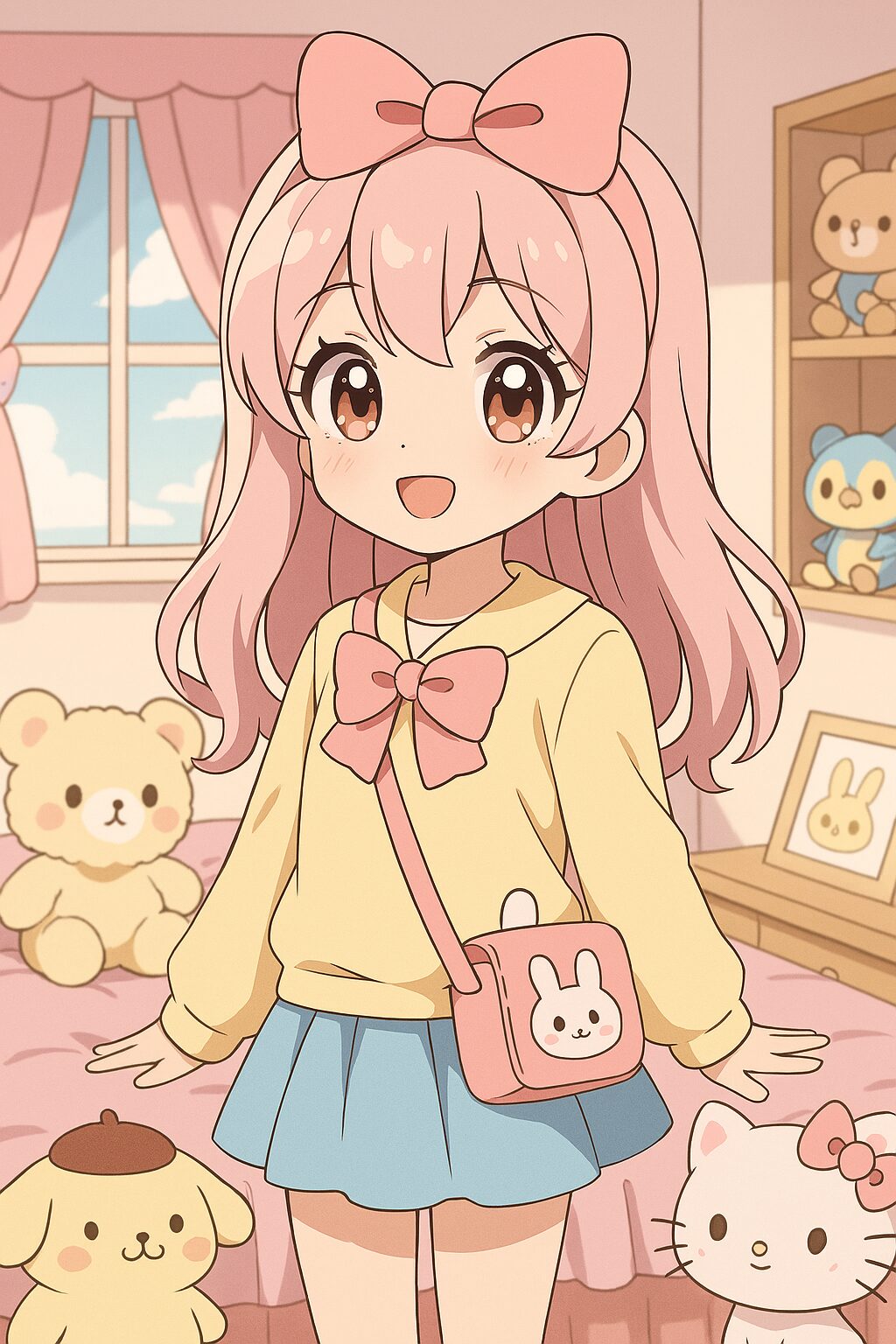- Introduction: Why “Kawaii” Is More Than Just Cute
- 🧁 The Origins of Kawaii: From Ancient Aesthetics to Modern Pop
- 🎀 The Rise of Kawaii Icons: Hello Kitty and Beyond
- 👗 Kawaii Fashion: Harajuku and the Art of Self-Expression
- 🍱 Kawaii in Everyday Life: Food, Stationery, and Mascots
- 🌏 Why the World Loves Kawaii
- 💡 How to Experience Kawaii Yourself
- 📝 Conclusion: Kawaii Is Kindness in Disguise
- 🔗 External References
- はじめに:「かわいい」は単なる可愛さではない
- 🧁 カワイイの起源:古代の美意識から現代ポップへ
- 🎀 カワイイの象徴:ハローキティと仲間たち
- 👗 カワイイファッション:原宿と自己表現の芸術
- 🍱 日常にあるカワイイ:食べ物・文房具・マスコット
- 🌏 なぜ世界はカワイイに惹かれるのか
- 💡 あなたもカワイイを体験してみよう
- 📝 まとめ:カワイイはやさしさの表現
- 🔗 外部参考リンク
Introduction: Why “Kawaii” Is More Than Just Cute
If you’ve ever walked through Tokyo’s Harajuku district, browsed Japanese stationery, or watched anime, you’ve likely encountered the word “Kawaii.” Translated as “cute” or “adorable,” this term has evolved far beyond its dictionary definition. Today, “Kawaii” represents a cultural phenomenon that touches fashion, art, behavior, and even philosophy.
But what exactly is Kawaii culture? Where did it come from? And why has it become a global language of joy and self-expression?
🧁 The Origins of Kawaii: From Ancient Aesthetics to Modern Pop
Heian Period: The Seeds of Softness
The concept of “cuteness” isn’t new in Japan. As early as the Heian period (794–1185), court literature like The Pillow Book by Sei Shōnagon described small, delicate things—baby birds, miniature furniture, children’s clothing—as “utsukushi,” a word closely related to today’s “kawaii”.
Post-War Rebellion: Schoolgirls and Round Letters
In the 1970s, Japanese teenage girls began writing in a new style called marui ji (“round letters”)—a bubbly, childlike script filled with hearts, stars, and cartoon faces. This was more than a handwriting trend; it was a quiet rebellion against rigid societal norms.
Schools banned the style, but advertisers embraced it. Soon, “kawaii” became a marketing tool, and the culture of cuteness exploded.
🎀 The Rise of Kawaii Icons: Hello Kitty and Beyond
Sanrio’s Masterstroke: Hello Kitty
In 1974, Sanrio introduced Hello Kitty—a mouthless white cat with a red bow. Designed by Yuko Shimizu, Hello Kitty was intentionally expressionless, allowing people to project their own emotions onto her.
She became a global superstar, adorning everything from coin purses to airplanes. Her success proved that “kawaii” could be both emotionally resonant and commercially powerful.
Other Beloved Characters
- Rilakkuma: A lazy bear who loves pancakes and naps
- Gudetama: A depressed egg yolk with existential vibes
- Totoro: A gentle forest spirit from Studio Ghibli’s My Neighbor Totoro
- Pompompurin: A golden retriever who wears a beret and loves pudding
👗 Kawaii Fashion: Harajuku and the Art of Self-Expression
Harajuku: The Epicenter of Cute
Tokyo’s Harajuku district is a living museum of Kawaii fashion. From pastel Lolita dresses to punk-inspired accessories, young people use clothing to express their inner worlds.
Global Influence
Kawaii fashion has inspired designers worldwide. Gwen Stefani’s “Harajuku Girls,” Western pop stars wearing Japanese streetwear, and international cosplay events all reflect the global reach of this aesthetic.
🍱 Kawaii in Everyday Life: Food, Stationery, and Mascots
Bento Boxes and Character Cafés
In Japan, even lunch is cute. Kyaraben (character bento) features rice shaped like animals, vegetables cut into stars, and eggs with smiling faces. Cafés themed around characters like Pikachu or Rilakkuma offer immersive experiences in edible cuteness.
Stationery and School Supplies
Japanese stationery is a global obsession. Stickers, notebooks, and pens often feature adorable designs that turn mundane tasks into moments of joy.
Mascots with Meaning
- Kumamon (Kumamoto): A bear with wide eyes and red cheeks
- Funassyi (Funabashi): A pear fairy who screams and dances
🌏 Why the World Loves Kawaii
Emotional Universality
Kawaii transcends language. A smiling cat, a sleepy egg, or a pastel dress can evoke warmth and empathy across cultures. Psychologists suggest that “cute” things trigger nurturing instincts and increase focus.
Cultural Diplomacy
Japan has embraced Kawaii as a soft power tool. The government appointed “Kawaii Ambassadors” to promote Japanese culture abroad. Events like Japan Expo in Paris and Anime Expo in Los Angeles showcase Kawaii fashion, art, and philosophy to global audiences.
💡 How to Experience Kawaii Yourself
Online Shopping
You don’t need to visit Japan to enjoy Kawaii culture. Websites like Buyee and ZenMarket allow international users to buy Japanese products directly.
Social Media Inspiration
Follow hashtags like #kawaii, #harajukufashion, or #cutestickers on Instagram and TikTok. You’ll find creators sharing outfits, crafts, and lifestyle tips.
Try It at Home
- Decorate your planner with stickers
- Make a character-themed lunch
- Wear pastel colors and accessories
- Create your own mascot or doodle
📝 Conclusion: Kawaii Is Kindness in Disguise
At its core, Kawaii is about gentleness. It’s a celebration of softness in a world that often demands hardness. It’s a way to connect, to express, and to heal.
Whether you’re a fan of Hello Kitty or just curious about Japanese culture, embracing Kawaii is an invitation to see the world with kinder eyes.
🔗 External References
- The History of Kawaii Culture – YouGoJapan
- Global Spread of Kawaii – Nasu Utopia
- Kawaii Culture Explained – EJable
- Beyond Cuteness – Japan House LA
🌸 「かわいい」とは?世界を魅了する日本のカワイイ文化
はじめに:「かわいい」は単なる可愛さではない
東京・原宿を歩いたことがある方、日本の文房具を見たことがある方、アニメを観たことがある方なら、「かわいい(Kawaii)」という言葉に出会ったことがあるでしょう。英語では「cute(可愛い)」と訳されますが、この言葉は辞書的な意味を超えて、今やファッション、アート、行動、哲学にまで広がる文化現象となっています。
では、「かわいい文化」とは何でしょうか?その起源は?そして、なぜ世界中の人々がこの言葉に共感するのでしょうか?
🧁 カワイイの起源:古代の美意識から現代ポップへ
平安時代:やさしさの種
「かわいさ」の概念は日本に古くから存在します。平安時代(794〜1185年)の宮廷文学『枕草子』では、小鳥や小さな家具、子ども用の衣服など、繊細で小さなものが「うつくし」と表現されていました。この言葉は、現代の「かわいい」に近い感覚を持っています。
戦後の反抗:女子高生と丸文字
1970年代、日本の女子高生たちは「丸文字」と呼ばれる新しい書き方を始めました。ハートや星、顔文字を使った子どもっぽい文字は、厳格な社会規範への静かな反抗でもありました。
学校では禁止されましたが、広告業界はこのスタイルを歓迎。やがて「かわいい」はマーケティングの武器となり、文化として広がっていきました。
🎀 カワイイの象徴:ハローキティと仲間たち
サンリオの傑作:ハローキティ
1974年、サンリオはハローキティを発表しました。口のない白い猫に赤いリボン。デザイナーの清水侑子は、見る人が自分の感情を投影できるよう、表情をあえて省きました。
ハローキティは世界的なスターとなり、財布から飛行機まであらゆる商品に登場。「かわいい」は感情を動かす力と商業的価値を持つことが証明されました。
その他の人気キャラクター
- リラックマ:パンケーキと昼寝が好きな怠け者のクマ
- ぐでたま:やる気のない卵の黄身、哲学的なつぶやきが人気
- トトロ:スタジオジブリ『となりのトトロ』に登場する森の精霊
- ポムポムプリン:ベレー帽をかぶったプリン好きのゴールデンレトリバー
👗 カワイイファッション:原宿と自己表現の芸術
原宿:かわいいの聖地
東京・原宿は、カワイイファッションの生きた博物館です。パステルカラーのロリータドレスからパンク風アクセサリーまで、若者たちは服を通じて自分の内面を表現しています。
世界への影響
カワイイファッションは世界中のデザイナーに影響を与えています。グウェン・ステファニーの「Harajuku Girls」、欧米のポップスターによる日本風の衣装、国際的なコスプレイベントなどがその例です。
🍱 日常にあるカワイイ:食べ物・文房具・マスコット
キャラ弁とテーマカフェ
日本では、ランチさえもかわいくなります。キャラ弁(キャラクター弁当)は、動物の形をしたご飯、星型の野菜、笑顔の卵などで構成されます。ピカチュウやリラックマなどのキャラクターカフェも人気です。
文房具と学用品
日本の文房具は世界中で人気です。シール、ノート、ペンなどにかわいいデザインが施され、日常の作業が楽しくなります。
意味のあるマスコット
- くまモン(熊本県):大きな目と赤いほっぺのクマ
- ふなっしー(船橋市):叫んで踊る梨の妖精
🌏 なぜ世界はカワイイに惹かれるのか
感情の普遍性
カワイイは言語を超えます。笑顔の猫、眠そうな卵、パステルカラーの服は、文化を越えて温かさや共感を呼び起こします。心理学的には、「かわいいもの」は人の保護本能を刺激し、集中力を高めるとも言われています。
文化的な外交手段
日本はカワイイを「ソフトパワー」として活用しています。政府は「カワイイ大使」を任命し、海外で日本文化を紹介。パリのジャパンエキスポやロサンゼルスのアニメエキスポでは、カワイイファッションやアート、哲学が紹介されています。
💡 あなたもカワイイを体験してみよう
オンラインショッピング
日本に来なくても、カワイイ文化は楽しめます。以下のサイトでは、海外から日本の商品を購入できます: Buyee、 ZenMarket
SNSでインスピレーションを
InstagramやTikTokで、#kawaii、#harajukufashion、#cutestickersなどのハッシュタグを検索してみましょう。世界中のクリエイターが、ファッション、クラフト、ライフスタイルを共有しています。
自宅でできるカワイイ体験
- 手帳にシールを貼ってデコレーション
- キャラクター弁当を作ってみる
- パステルカラーの服やアクセサリーを身につける
- 自分だけのマスコットやイラストを描いてみる
📝 まとめ:カワイイはやさしさの表現
カワイイの本質は「やさしさ」です。厳しい世界の中で、柔らかさや優しさを称える文化。それは、つながり、表現し、癒すための手段でもあります。
ハローキティのファンであっても、日本文化に興味を持ち始めたばかりでも、カワイイを受け入れることは、世界を少しやさしく見るための第一歩なのです。



コメント